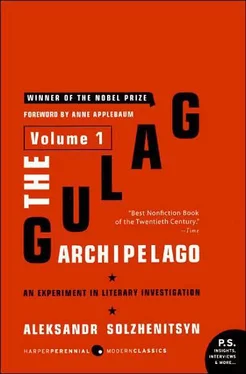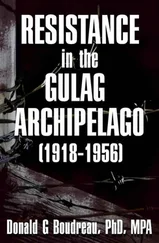During the twenties the prisoner’s food was very decent in the isolators for politicals (still called “politizakrytki”—“political lock-ups”—by the prisoners): the lunches always included some meat; fresh vegetables were served; milk could be bought in the commissary. In 1931-1933 the food deteriorated sharply, but things were no better out in freedom at that time. Both scurvy and dizziness from lack of food were no rarity in the prisons for politicals in those years. Later on the food improved, but it was never the same as before. In 1947, in the Vladimir TON, I. Korneyev was constantly hungry: one pound of bread, two pieces of sugar, two hot dishes which were not at all filling; the only thing available in unlimited quantities was boiling water. (It will, of course, be said once more that this was not a typical year and there was hunger outside in freedom, too, at the time. This was when they generously allowed freedom to feed prison: unlimited parcels were permitted.) The light in cells was always “rationed,” so to speak, in both the thirties and the forties: the “muzzles” on the windows and the frosted reinforced glass created a permanent twilight in the cells (darkness is an important factor in causing depression). They often stretched netting above the window “muzzle,” and in the winter it was covered with snow, which cut off this last access to the light. Reading became no more than a way of ruining one’s eyes. In the Vladimir TON, they made up for this lack of light at night: bright electric lights burned all night long, preventing sleep. And in the Dmitrovsk Prison in 1938 (N. A. Kozyrev), there was light in the evenings and at night—a kerosene lamp on a little shelf way up near the ceiling, that burned away and smoked up the last air; in 1939 there were electric lights that glowed red at half-voltage. Air was “rationed” too. The hinged panes for ventilation were kept locked, and opened only during the interval of the prisoners’ trip to the toilet, as prisoners recall from both Dmitrovsk and Yaroslavl prisons. (Y. Ginzburg: The bread grew moldy between morning and lunchtime; the sheets were damp, and the walls green.) In Vladimir in 1948 there was no lack of air, because the transom was open permanently. Walks outdoors ranged from fifteen to forty-five minutes at various hours in various prisons. There was no such thing as the communication with the soil that had existed in Schlusselburg or Solovki; everything that grew had been torn up by the roots, trampled, covered with concrete and asphalt. They even forbade lifting up one’s head to the heavens during the walks: “Look at your feet!” This was the command both Kozyrev and Adamova remember from the Kazan Prison. Visits from relatives were forbidden in 1937 and never renewed. Letters could be sent to close relatives twice a month and could be received from them in most years. (But in Kazan they had to be returned to the administration the day after they had been read.) Access to the commissary to make purchases with the money sent in specifically limited amounts was usually permitted. Furniture was no unimportant part of the prison regimen. Adamova wrote eloquently of her happiness at finding a simple wooden cot with a straw mattress and a simple wooden table in her cell in Suzdal, after having had only cots that folded into the wall and chairs anchored to the floor. In the Vladimir TON, I. Korneyev experienced two different prison regimens:
Under one, in 1947-1948, personal articles were not removed from the cell; one could lie down during the day; and the turnkey very seldom looked through the peephole. But under the other, in 1949-1953, the cell was locked with two locks (the responsibility of the turnkey and duty officer respectively); one was forbidden to lie down, forbidden to talk in a normal voice (in Kazan, only in a whisper); personal articles were all taken away; a uniform of striped mattress ticking was issued; correspondence was permitted only twice a year and only on those days announced without warning by the chief of the prison (anyone who missed that day couldn’t write), and only a sheet of paper half the size of a postal sheet could be used; violent searches and unscheduled visits were frequent, requiring the complete turning out of one’s belongings and undressing down to one’s skin. Communication between cells was prohibited to such an extent that the jailers went through the toilets with a portable lantern after each toilet visit and searched in each hole. The entire cell would get punish-merit cells for graffiti in the toilets. The punishment cells were a scourge in the Special Purpose Prisons. One could get into a punishment cell for coughing. (“Cover your head with your blanket. Then you can cough!”) Or for walking around the cell (Kozyrev: “It was considered to be rebellious”); for the noise made by one’s shoes. (In the Kazan Prison women had been issued men’s shoes that were much too large for women’s feet—size 10½.) Incidentally, Ginzburg was correct in concluding that periods in a punishment cell were meted out not for any particular misdemeanor but according to a schedule: every prisoner was required to spend some time there in order to learn what it was like. And the rules included another generally applicable point: “In the event of any display of unruliness in a punishment cell [?], the chief of the prison has the right to extend the term of incarceration there to twenty days.” Just what was meant by unruliness? Here’s what happened to Kozyrev. (The descriptions of the punishment cell and much else in the prison regimen tally to such an extent among all sources that the stamp of a single system of administrative rules can be detected.) He was given another five days in the punishment cell for pacing back and forth. In the autumn, the building containing the punishment cells was unheated, and it was very cold. They forced prisoners to undress down to their underwear and to take off their shoes. The floor was bare earth and dust (it might be wet dirt; and in the Kazan Prison it might even be covered with water). Kozyrev had a stool in his. (Ginzburg had none in hers.) He immediately concluded that he would perish, that he would freeze to death. But some kind of mysterious inner warmth gradually made itself felt, and it was his salvation. He learned to sleep sitting on his stool. They gave him a mug of hot water three times a day; it made him drunk. One of the duty officers, in violation of the rules, pressed a piece of sugar into his ten-and-a-half-ounce bread ration. On the basis of the rations issued him, and by observing the light from some faraway, tiny, labyrinthine window, Kozyrev kept count of the days. His five days had come to an end, but he had not been released. His sense of hearing had become extremely acute and he heard whispers in the corridor—having to do with either “the sixth” or “six days.” This was a provocation: they were waiting for him to say that his five days were over and that it was time to let him out. That would have constituted unruliness, for which his stay in the punishment cell would have been prolonged. But he sat silent and obedient for another day, and then they let him out, just as if everything had been the way it was supposed to be. (Perhaps the chief of the prison used this method for testing all the prisoners in turn for submissiveness? And then he could sentence all those who weren’t yet submissive enough to further terms in the punishment cell.) After the punishment cell the ordinary cell seemed like a palace. Kozyrev became deaf for half a year, and he began to get abscesses in his throat. His cellmate went insane from frequent imprisonment in the punishment cell, and Kozyrev was kept locked up with an insane man for more than a year, with just the two of them there. (Nadezhda Surovtseva recalls many cases of insanity in political isolators—she herself recalls as many as Novorussky totaled up in the whole chronicle of Schliisselburg.)
Читать дальше












